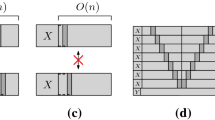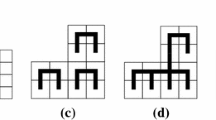Abstract
Tile self-assembly is a formal model of computation capturing DNA-based nanoscale systems. Here we consider the popular two-handed tile self-assembly model or 2HAM. Each 2HAM system includes a temperature parameter, which determines the threshold of bonding strength required for two assemblies to attach. Unlike most prior study, we consider general temperatures not limited to small, constant values. We obtain two results. First, we prove that the computational complexity of determining whether a given tile system uniquely assembles a given assembly is coNP-complete, confirming a conjecture of Cannon et al. (2013). Second, we prove that larger temperature values decrease the minimum number of tile types needed to assemble some shapes. In particular, for any temperature \(\tau \in \{3, \dots \}\), we give a class of shapes of size n such that the ratio of the minimum number of tiles needed to assemble these shapes at temperature \(\tau \) and any temperature less than \(\tau \) is \(\varOmega (n^{1/(2\tau +2)})\).
This research was supported in part by National Science Foundation Grant CCF-1555626.
Access this chapter
Tax calculation will be finalised at checkout
Purchases are for personal use only
Similar content being viewed by others
Notes
- 1.
Note that only matching glues have positive strength. The more general model of “flexible glues” where non-matching glue pairs may also have positive strength has been considered [7].
References
Abel, Z., Benbernou, N., Damian, M., Demaine, E.D., Demaine, M.L., Flatland, R., Kominers, S.D., Schweller, R.T.: Shape replication through self-assembly and RNase enzymes. In: Proceedings of the Twenty-First Annual ACM-SIAM Symposium on Discrete Algorithms, pp. 1045–1064 (2010)
Adleman, L., Cheng, Q., Goel, A., Huang, M.-D.: Running time and program size for self-assembled squares. In: Proceedings of the 33rd Annual ACM Symposium on Theory of Computing (STOC), pp. 740–748 (2001)
Adleman, L.M., Cheng, Q., Goel, A., Huang, M.-D.A., Kempe, D., de Espanés, P.M., Rothemund, P.W.K.: Combinatorial optimization problems in self-assembly. In: Proceedings of the Thirty-Fourth Annual ACM Symposium on Theory of Computing, pp. 23–32 (2002)
Cannon, S., Demaine, E.D., Demaine, E.D., Eisenstat, S., Patitz, M.J., Schweller, R., Summers, S.M., Winslow, A.: Two hands are better than one (up to constant factors): self-assembly in the 2HAM vs. aTAM. In: Proceedings of 30th International Symposium on Theoretical Aspects of Computer Science (STACS). LIPIcs, vol. 20, pp. 172–184. Schloss Dagstuhl (2013)
Chen, H.-L., Doty, D.: Parallelism and time in hierarchical self-assembly. In: Proceedings of the 23rd Annual ACM-SIAM Symposium on Discrete Algorithms, SODA 2012, pp. 1163–1182. SIAM (2012)
Chen, H.-L., Doty, D., Seki, S.: Program size and temperature in self-assembly. Algorithmica 72(3), 884–899 (2015)
Cheng, Q., Aggarwal, G., Goldwasser, M.H., Kao, M.-Y., Schweller, R.T., de Espanés, P.M.: Complexities for generalized models of self-assembly. SIAM J. Comput. 34, 1493–1515 (2005)
Demaine, E.D., Patitz, M.J., Rogers, T.A., Schweller, R.T., Summers, S.M., Woods, D.: The two-handed tile assembly model is not intrinsically universal. Algorithmica 74(2), 812–850 (2016)
Doty, D.: Producibility in hierarchical self-assembly. Nat. Comput. 15(1), 41–49 (2016)
Doty, D., Lutz, J.H., Patitz, M.J., Schweller, R., Summers, S.M., Woods, D.: The tile assembly model is intrinsically universal. In: Proceedings of the 53rd IEEE Conference on Foundations of Computer Science (FOCS), pp. 302–310 (2012)
Doty, D., Patitz, M.J., Reishus, D., Schweller, R.T., Summers, S.M.: Strong fault-tolerance for self-assembly with fuzzy temperature. In: Proceedings of the 51st Annual IEEE Symposium on Foundations of Computer Science (FOCS 2010), pp. 417–426 (2010)
Doty, D., Patitz, M.J., Summers, S.M.: Limitations of self-assembly at temperature one. In: Deaton, R., Suyama, A. (eds.) DNA 2009. LNCS, vol. 5877, pp. 35–44. Springer, Heidelberg (2009). doi:10.1007/978-3-642-10604-0_4
Itai, A., Papadimitriou, C.H., Szwarcfiter, J.L.: Hamilton paths in grid graphs. SIAM J. Comput. 11(4), 676–686 (1982)
Kao, M.-Y., Schweller, R.T.: Reducing tile complexity for self-assembly through temperature programming. In: Proceedings of the 17th Annual ACM-SIAM Symposium on Discrete Algorithms, SODA 2006, pp. 571–580 (2006)
Luhrs, C.: Polyomino-safe DNA self-assembly via block replacement. Nat. Comput. 9(1), 97–109 (2010)
Maňuch, J., Stacho, L., Stoll, C.: Two lower bounds for self-assemblies at temperature 1. J. Comput. Biol. 16(6), 841–852 (2010)
Meunier, P.-E.: The self-assembly of paths and squares at temperature 1. Technical report, arXiv (2013). http://arxiv.org/abs/1312.1299
Meunier, P.-E., Patitz, M.J., Summers, S.M., Theyssier, G., Winslow, A., Woods, D.: Intrinsic universality in tile self-assembly requires cooperation. In: Proceedings of the 25th Annual ACM-SIAM Symposium on Discrete Algorithms (SODA), pp. 752–771 (2014)
Patitz, M.J., Rogers, T.A., Schweller, R.T., Summers, S.M., Winslow, A.: Resiliency to multiple nucleation in temperature-1 self-assembly. In: Rondelez, Y., Woods, D. (eds.) DNA 2016. LNCS, vol. 9818, pp. 98–113. Springer, Cham (2016). doi:10.1007/978-3-319-43994-5_7
Rothemund, P.W.K., Winfree, E.: The program-size complexity of self-assembled squares (extended abstract). In: Proceedings of the 32nd ACM Symposium on Theory of Computing (STOC), pp. 459–468 (2000)
Schulman, R., Winfree, E.: Programmable control of nucleation for algorithmic self-assembly. SIAM J. Comput. 39(4), 1581–1616 (2009)
Schweller, R., Winslow, A., Wylie, T.: Verification in staged tile self-assembly. In: Patitz, M.J., Stannett, M. (eds.) UCNC 2017. LNCS, vol. 10240, pp. 98–112. Springer, Cham (2017). doi:10.1007/978-3-319-58187-3_8
Seeman, N.C.: Nucleic-acid junctions and lattices. J. Theor. Biol. 99, 237–247 (1982)
Seki, S., Ukuno, Y.: On the behavior of tile assembly system at high temperatures. Computability 2(2), 107–124 (2013)
Soloveichik, D., Winfree, E.: Complexity of self-assembled shapes. SIAM J. Comput. 36(6), 1544–1569 (2007)
Summers, S.M.: Reducing tile complexity for the self-assembly of scaled shapes through temperature programming. Algorithmica 63(1), 117–136 (2012)
Winfree, E.: Algorithmic self-assembly of DNA. Ph.D. thesis, California Institute of Technology (1998)
Woods, D.: Intrinsic universality and the computational power of self-assembly. Philos. Trans. R. Soc. A 373, 2015 (2046)
Author information
Authors and Affiliations
Corresponding author
Editor information
Editors and Affiliations
Rights and permissions
Copyright information
© 2017 Springer International Publishing AG
About this paper
Cite this paper
Schweller, R., Winslow, A., Wylie, T. (2017). Complexities for High-Temperature Two-Handed Tile Self-assembly. In: Brijder, R., Qian, L. (eds) DNA Computing and Molecular Programming. DNA 2017. Lecture Notes in Computer Science(), vol 10467. Springer, Cham. https://doi.org/10.1007/978-3-319-66799-7_7
Download citation
DOI: https://doi.org/10.1007/978-3-319-66799-7_7
Published:
Publisher Name: Springer, Cham
Print ISBN: 978-3-319-66798-0
Online ISBN: 978-3-319-66799-7
eBook Packages: Computer ScienceComputer Science (R0)




